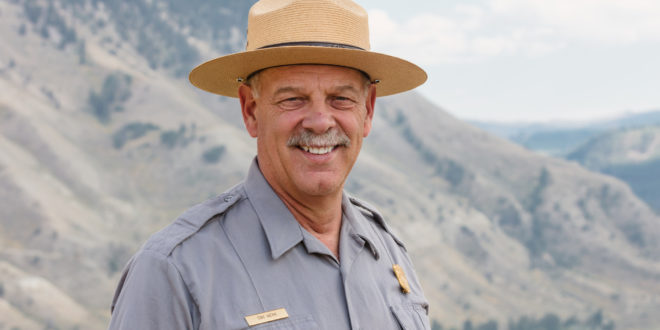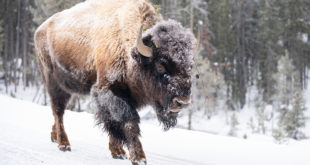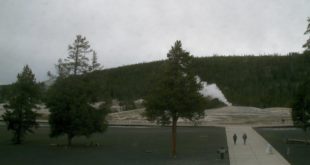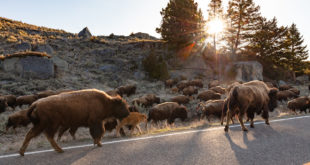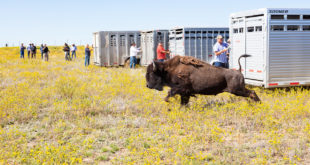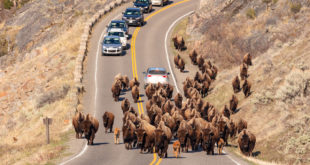After the threat of a potential reassignment as part of a Department of the Interior shakeup, Yellowstone National Park Superintendent Dan Wenk is retiring in 2019, ending a 43-year-career with the National Park Service.
“I’ve had an amazing career with the National Park Service,” Wenk said in a press statement. “It is an honor and a privilege to preserve national park resources and provide incredible visitor experiences, and I’m not done yet. I’m in the midst of several important projects that I will finish before I depart to ensure the smoothest transition for Yellowstone.”
Wenk will spend the rest of his tenure, tentatively set to end on March 30, 2019, focusing on wrapping up several high-profile projects, including bison management, long-term visitation planning, concessions contracts, regional wildlife issues and workplace culture with National Park Service staff.
Later this year, the park plans to ship bison to the Fort Peck Indian Reservation, which has sought to establish a herd of Yellowstone bison outside the park for years. The park has also sought to establish a quarantine program where bison are screened for brucellosis. Once clean, they can be shipped outside of the park to other conservation herds.
The move comes following a series of protests against the hunting and slaughter of bison under the Interagency Bison Management Plan. Five protesters were arrested in March, following attempts to block the shipment of bison to slaughter. Fences were also cut twice at Stephens Creek in January and February 2018, releasing bison being held.
Looking at fisheries, the park is gearing up for its annual program against lake trout, an invasive species that have displaced the native cutthroat trout species in Yellowstone Lake. Although the program has posted tangible gains in the past few years, fishery experts and biologists say the work is far from over.
Ideed, with the approach of summer, visitation to Yellowstone National Park kicks into high gear. Last year, for instance, over 4.1 million people visited Yellowstone National Park. The year before that, nearly 4.3 million people came to the park, which broke the record for Yellowstone visitation.
As mentioned, the sheer amount of people and cars in Yellowstone National Park, coupled with delays in maintenance and infrastructure repair, has left its toll on park roads and facilities. A pair of visitor and traffic studies released last year, for instance, say the park’s road system could become terminally poor by 2023 if traffic remains the same or increases. The studies also show that many visitors think the park is overcrowded.
Political Considerations at Play?
As noted, the threat of a potential reassignment as part of a Department of the Interior shakeup played a role in Wenk’s decision to retire. And this is where something untoward emerges: potential National Park Service and Department of the Interior assignments based on loyalty to President Donald Trump, rather than fealty to the mission of the National Park Service. From the Washington Post:
The department declined Thursday to comment about Wenk, instead issuing a general statement about President Trump’s executive order to reorganize the federal government. Interior Secretary Ryan Zinke “has been absolutely out front on that issue,” the statement by spokeswoman Heather Swift said.
Specific rules govern senior executive service reassignments, and Interior broke several in a flurry of transfers last year. Its Office of Inspector General subsequently weighed in, saying no transfers are allowed until about four months after the Senate confirms a presidential nominee as secretary. The 35 executives involved received notice within just 106 days after Zinke’s confirmation on March 1, 2017….
But a chorus of career staffers and conservation groups have said that such moves can be retaliation against employees who have spoken out against administration policies. The moves have drawn particular suspicion given Zinke’s claim last year that a third of his employees were not “loyal to the flag.”
“A lot of their desire is not about competence; it’s about loyalty,” former Park Service director Jonathan B. Jarvis said. “They’re looking for loyalty, whatever that means, in terms of delivering on an agenda. When you move to transfer someone like Dan, who has a lot of integrity, you send a message to the rest of the field that this is what they expect: loyalty. It’s that simple, and sad.”
As the current superintendent of Yellowstone National Park since 2011, Wenk manages more than 2.2 million acres, a staff of 800, and an annual budget of more than $60 million.
Wenk served as Deputy Director of Operations for the National Park Service in Washington D.C. from 2007 through 2011. He served as Acting Director of the National Park Service for nine months in 2009. In these national roles, Wenk received the Department of the Interior Secretary’s Executive Leadership Award and the Presidential Rank Award.
Wenk’s career with the National Park Service began in 1975 as a landscape architect. He was named Superintendent of Mount Rushmore National Memorial in 1985 where he served for 16 years. In 2001, he was appointed the Director of the Denver Service Center, which is the National Park Service’s central office with responsibility for planning, design and construction.
RELATED STORIES: Yellowstone Superintendent Dan Wenk Mulls Future at Park
 Yellowstone Insider Your Complete Guide to America's First National Park
Yellowstone Insider Your Complete Guide to America's First National Park
